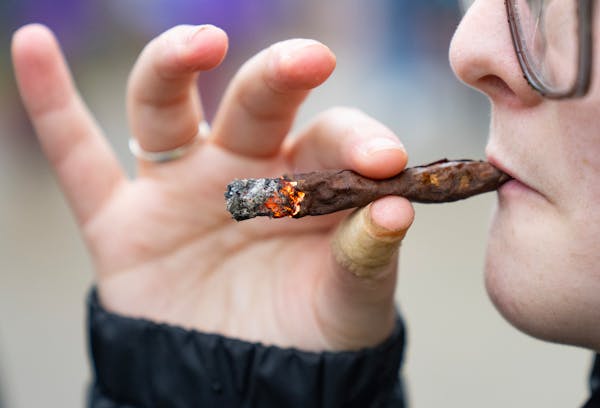Recreational marijuana becomes legal in Minnesota next Tuesday, and law enforcement is preparing to cite motorists or passengers who smoke in vehicles.
"If you smoke while you roll around we will arrest you," warned New Hope Police Chief Tim Hoyt. "That has not changed. Smoke it at home."
Operating boats, ATVs and snowmobiles while using or under the influence of cannabis is also illegal, said Col. Rodmen Smith, director of the Department of Natural Resources' Enforcement Division.
"It doesn't matter what type of motor vehicle you are driving," he said during a news conference Tuesday, where officials said they are ready to enforce the new law in the same way they police drunken driving.
With $10 million in state funding allocated by the Legislature for enforcement this year and $5 million in subsequent years, public safety officials will flood the airwaves on TV and radio, social media and in bars, restaurants and retail locations to educate the public about the dangers of driving while under the influence of pot — and the consequences for those who get caught.
A question-and-answer section about marijuana will be added to the Department of Public Safety (DPS) website, officials said. Funding will also go toward training more drug recognition specialists to spot signs that a motorist may be impaired, including dilated pupils, bloodshot eyes, body tremors and slurred speech.
As part of a pilot program, drivers who are stopped by police for suspected marijuana use will be asked to participate in a voluntary oral fluid roadside test. The driver, as with a test for alcohol, will give a saliva sample that can be used to determine the substance leading to impairment.
Those results will not be admissible in court, said Mike Hanson, director of the Department of Public Safety's Office of Traffic Safety. But they will be fed into a database and analyzed to help officials determine if the technology is a reliable detection method. Currently, there is no foolproof method to determine whether someone is under the influence of marijuana, because the drug can remain detectable in the body for weeks after use.
Minnesota has seen a 127% rise in drugged driving cases between 2017 and 2021 when compared with the previous 5-year period. Arrests rose from 7,000 to 16,000, with devastating effects, said Col. Matt Langer with the State Patrol.
"It is concerning," Hanson said. So far this year, 29 drivers have died in wrecks attributed to alcohol use, 21 to drug use and 13 to a combination of both. "We have a problem with that. You need to make the smart, right choice. There are no excuses to be in the back of a squad car, ambulance or, heaven forbid, a hearse."
According to DPS, cannabinoids are one of the most prevalent drug classes found in driving under the influence of drugs (DUID) cases. From January 2021 through June 2022, the cannabinoid drug class was found in nearly 60% of approximately 7,000 blood and urine samples.
Local agencies also are preparing for the new law. In Brooklyn Park, the police department has doubled the number of drug recognition experts on staff to four and is expected to add two more by the beginning of 2024, said Inspector Elliot Faust. The agency is the regional coordinator for Toward Zero Deaths, and is using that funding to focus on impaired driving, including drug impairment, he said.
Motorists are not allowed to transport open packages of marijuana in a vehicle. It must be in sealed, original packaging or placed in a part of the vehicle inaccessible to occupants, such as the trunk. Violating that provision is similar to breaking the law forbidding open containers of alcohol in a vehicle, and it is punishable as a similar offense, Langer said.
"This is a big change," Langer said. "Our troopers are vigilant for all things causing impairment, and we will do as much of that next week as we do today."

Singles title puts St. Paul school on a whole new badminton level

Trump says Minneapolis would have burned down without him

Wolves fans are pumped, cautiously optimistic at Game 6


